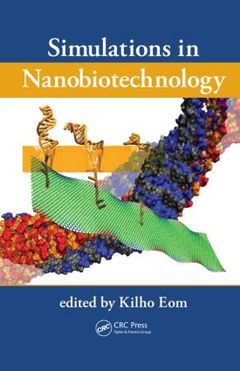Simulations in Nanobiotechnology
Coordonnateur : Eom Kilho

Until the late 20th century, computational studies of biomolecules and nanomaterials had considered the two subjects separately. A thorough presentation of state-of-the-art simulations for studying the nanoscale behavior of materials, Simulations in Nanobiotechnology discusses computational simulations of biomolecules and nanomaterials together. The book gives readers insight into not only the fundamentals of simulation-based characterizations in nanobiotechnology, but also in how to approach new and interesting problems in nanobiotechnology using basic theoretical and computational frameworks.
Presenting the simulation-based nanoscale characterizations in biological science, Part 1:
- Describes recent efforts in MD simulation-based characterization and CG modeling of DNA and protein transport dynamics in the nanopore and nanochannel
- Presents recent advances made in continuum mechanics-based modeling of membrane proteins
- Summarizes theoretical frameworks along with atomistic simulations in single-molecule mechanics
- Provides the computational simulation-based mechanical characterization of protein materials
Discussing advances in modeling techniques and their applications, Part 2:
- Describes advances in nature-inspired material design; atomistic simulation-based characterization of nanoparticles? optical properties; and nanoparticle-based applications in therapeutics
- Overviews of the recent advances made in experiment and simulation-based characterizations of nanoscale adhesive properties
- Suggests theoretical frameworks with experimental efforts in the development of nanoresonators for future nanoscale device designs
- Delineates advances in theoretical and computational methods for understanding the mechanical behavior of a graphene monolayer
The development of experimental apparatuses has paved the way to observing physics at the nanoscale and opened a new avenue in the fundamental understanding of the physics of various objects such as biological materials and nanomaterials. With expert contributors from around the world, this book addresses topics such as the molecular dynamics of protein translocation, coarse-grained modeling of CNT-DNA interactions, multi-scale modeling of nanowire resonator sensors, and the molecular dynamics simulation of protein mechanics. It demonstrates the broad application of models and simulations that require the use of principles from multiple academic disciplines.
Introduction. Molecular Dynamics of Protein Translocation. Coarse-Grained Modeling of DNA Translocation through Nanopore. Atomistic Simulation of Auger Process in Nanoparticle-Based Theragnostics. Coarse-Grained Modeling of CNT-DNA Interaction. Molecular Dynamics of CNT-DNA Interaction. Modeling of CNT-DNA Hybrid Complex. Coarse-Grained Modeling of Nano-Cantilever-Based DNA Detection. Coarse-Grained Modeling of Micro- or Nano-Cantilever Sensors for Atomistic Detection. Continuum Modeling of CNT -Based Molecular Recognitions. Multi-Scale Modeling of Nanowire Resonator Sensors. Cauchy-Born Rule for Modeling Graphene Sheet. Coarse-Grained Modeling of Single-Molecule Experiments. Coarse-Grained Modeling of Protein Dynamics. Molecular Dynamics Simulation of Protein Mechanics. Continuum Modeling of Large Protein Complex. Modeling of Biomimetic Adhesive.
Dr. Kilho Eom received a Ph.D. degree from the University of Texas at Austin in 2005. Between 2005 and 2008, he was a research scientist (2005-2007) and senior research scientist (2008) at Korea Institute of Science and Technology. Since 2008, he has been a research professor in the Department of Mechanical Engineering in Korea University. He has expertise in nanomechanics, and nanoscale physics of various objects ranging from biological molecules and cells to nanomaterials. He has served the editorial board member for ISRN Computational Mathematics.
Date de parution : 11-2011
15.6x23.4 cm
Disponible chez l'éditeur (délai d'approvisionnement : 15 jours).
Prix indicatif 220,72 €
Ajouter au panierDate de parution : 09-2018
15.6x23.4 cm
Thèmes de Simulations in Nanobiotechnology :
Mots-clés :
CG Model; MD Simulation; nanomaterials; Graphene Sheet; biomolecules; ENM; CNT-DNA Interaction; Force Extension Curve; coarse-grained modeling; Surface Stress; Multi-Scale Modeling; Resonant Frequency Shift; molecular dynamics; Spider Silk; Single Molecule Force Spectroscopy; Atomistic Simulations; Empirical Potential; Low Frequency Normal Modes; TM1 Helix; DNA Adsorption; MS Channel; Hairpin DNA; Equibiaxial Tension; DNA Translocation; Surface Stress Effect; S3 Helix; Armchair Edges; Resonant Energies; Protein Materials; SEM Image; TM2 Helices



